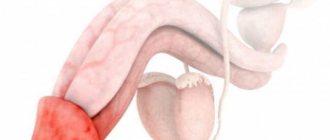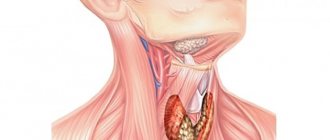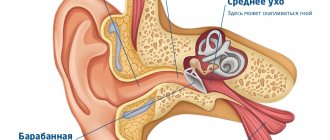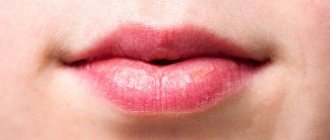November 3, 2020
When the head of the male organ becomes red and swollen, this is an inflammation called balanitis. When the foreskin is also involved in the process, the disease is called balanoposthitis. Redness is accompanied by itching, burning, pain when urinating, and sometimes mucus leaking from the urethra. The disease cannot be neglected; it can spread throughout the genitourinary system, provoke phimosis and lead to necrosis of the head.
Causes
The cause of inflammation of the head of the penis can be infectious or non-infectious. One of the main non-infectious causes is poor hygiene of the genital organs, as a result of which secretions begin to accumulate under the foreskin, which causes an inflammatory process. Other causes of inflammation of the head of the penis include:
- infectious and inflammatory diseases of the genitourinary system (urethritis, cystitis);
- skin diseases (psoriasis, dermatitis);
- narrowing of the foreskin (phimosis);
- trauma to the skin of the penis (burns, scratches);
- allergic reactions to hygiene products, underwear or contraceptives.
A common cause of inflammation of the glans penis in a child is uncomfortable underwear. It causes discomfort, rubs and injures the skin, causing balanitis in boys.
Complications
The main consequence of untreated balanoposthitis is phimosis (narrowing of the foreskin) or paraphimosis (pinching of the head of the penis by the narrowed foreskin), developing as a result of scarring of cracks or erosive foci of the prepuce.
Somewhat less frequently, balanoposthitis can cause other pathologies:
Symptoms
Inflammation of the glans begins with the appearance of spots and redness on the skin of the penis. Further, symptoms of balanitis in men occur, such as itching, burning, discomfort when trying to expose the tip of the penis. Pain appears during sexual intercourse.
As symptoms develop, inflammation of the head of the penis is accompanied by swelling, rash, and purulent whitish discharge. Patients experience difficulty urinating. Symptoms of balanitis are accompanied by aching pain, in rare cases – ulcerative lesions and erectile dysfunction.
According to the duration of symptoms, balanitis on the penis has an acute and chronic form.
Chronic balanitis has mild symptoms, and the acute condition often recurs due to a number of factors (decreased immunity, hypothermia).
Acute balanitis in men is divided into simple (catarrhal), erosive and gangrenous. With simple balanitis, inflammation of the head in men occurs in a mild form. Symptoms include hyperemia, swelling, itching and burning, and sometimes purulent discharge.
Erosive balanitis is characterized by the death of epithelial cells, the formation of whitish areas of skin, in place of which red erosions with maceration form. The pain syndrome intensifies.
With the gangrenous form of inflammation of the head of the penis in men, necrotic ulcers and severe swelling of the skin appear. This is accompanied by an increase in body temperature and malaise.
When the head of the penis becomes inflamed in boys, the threat is posed by possible complications that arise when the acute form becomes chronic. At this stage, there is a risk of adhesions and deformation of the penis. Also among the symptoms of inflammation of the head of the penis in a child are high body temperature (up to 39°), enlarged lymph nodes in the groin area, moodiness and sleep disturbances.
Why does the foreskin become inflamed?
The two main reasons for the development of posthitis in adults are unprotected sex and poor personal hygiene. Often inflammation begins due to a combination of these factors. In the fold of the foreskin in the area of the corolla of the glans, smegma (white plaque) accumulates - a lubricating secretion that is constantly produced by the glands. It is a favorable environment for the development of pathogenic flora. In some men, due to prolonged lack of hygiene, the smegma clumps and hardens, and stones form, which further injure the foreskin.
Postitis (inflamed leaf of the foreskin is indicated in red)
Postitis (inflamed leaf of the foreskin is indicated in red)
Posts (photo 18+) - https://prntscr.com/sb3hg4.
After sex, posthitis develops due to infection with fungi, herpes virus, staphylococcus, streptococcus, and sexually transmitted infections (chlamydia, gardnerella, trichomonas). Below is a photo of the inflamed area of the foreskin. The combination of genital herpes, gardnerella and staphylococcus caused redness, swelling, pus, and ulcers.
Other causes of inflammation of the inner layer of the foreskin:
- Allergy to detergent, fabric softener (appears when wearing underwear), condom lubricant or lubricant (allergic posthitis).
- Diabetes mellitus (diabetic posthitis). This disease provokes excessive dryness of the mucous membranes, as a result of which the inner layer of the foreskin is constantly rubbed and irritated. Microcracks contain heterogeneous microflora, which causes inflammation.
- Fungus. The genitourinary organs are predominantly affected by fungi of the genus Candida. Causes of candidal posthitis: infection from a partner, decreased immunity, for example, after a course of antibiotics. The fungus can live in the urethra without symptoms for years. When urinating, it gets on the skin of the foreskin and, under favorable conditions, begins to multiply. Main symptoms: redness of the skin of the prepuce, severe itching, and the appearance of a white clumping plaque.
- Irritation by urine when its normal composition is disrupted.
- Damage caused by sand released in the urine during urolithiasis. In such cases, the peak of discomfort occurs in the period after urination. Not everyone knows that they have stones or sand, so if they are not examined enough, problems with treatment arise - there are no infections, but irritation of the foreskin is present. Below are the doctors' answers to the question of a patient with posthitis due to urolithiasis.
Non-infectious inflammations are classified as nonspecific postitis.
Excerpts from the forum https://sprosivracha.com/questions/225990-razdrazhenie-krayney-ploti-posle-mocheispuskaniya:
Provoking factors include: wearing tight underwear, phimosis, short frenulum, alcohol abuse, vitamin deficiency. In the latter case, the general condition of the skin and mucous membranes worsens.
Diagnostics
Before treating inflammation of the glans in men, it is necessary to undergo a complete diagnosis. To carry out effective treatment, it is important to establish the cause of the disease. To relieve inflammation of the head of the penis, it is necessary to conduct a series of studies. In order to determine the susceptibility of pathogenic flora to the planned treatment of inflammation of the head, biomaterials are collected. A blood test is performed for the presence of infections (hepatitis, HIV, syphilis), a general blood test, a general urinalysis and a biopsy of the affected areas.
Treatment and diagnostic measures
Diagnosis in boys and men is carried out by a dermatovenerologist and urologist. The procedure includes a conversation between the doctor and the patient and examination of the genital organ. Based on the conversation and the inflamed appearance of the end of the genital organ, the doctor can easily diagnose balanoposthitis. But to get a complete picture, you will need to undergo a general blood test, urine test and tests for infections. If the doctor is not sure of the cause of the disease, he will have to undergo several more tests:
- test to check for diabetes;
- taking a sample from the head;
- blood chemistry;
- determining glucose levels;
- referral to a skin specialist;
- removal of a small sample of inflamed tissue.
Treatment
After receiving and analyzing the diagnostic results, the urologist determines how to cure balanitis and relieve inflammation of the head. Treatment of balanitis begins with strict adherence to personal hygiene. It is necessary to wash the penis with soap several times a day. By adhering to this rule in the early stages of the disease, you can stop the pathological process of inflammation of the head of the penis and avoid other types of treatment.
For more serious forms of inflammation of the head in men, drug treatment is prescribed. Medicines for balanitis have an antiseptic effect. Most often, inflammation of the glans penis is treated with ointments or creams.
In addition to ointments, the doctor can also prescribe drug therapy: tablets for the treatment of balanitis in men, for example, Suprax, Azithromycin.
In rare and complicated cases, surgical treatment is used - excision of the foreskin.
Medications
Ointments and creams for balanoposthitis | ||||
| № | Drug name | Purpose | Main components | Buyer rating |
| 1 | Levomekol | Has antimicrobial and anti-inflammatory effects | Methyluracil, Chloramphenicol. | 5 |
| 2 | Akriderm | For the treatment of aseptic forms of the disease | corticosteroid Betamethasone. | 5 |
| 3 | Triderm | For the treatment of inflammatory abnormalities | Betamethasone, Clotrimazole and Gentamicin. | 4,5 |
| 4 | Miramistin | For the treatment and prevention of sexually transmitted diseases | Ammonium chloride derivative | 4 |
| 5 | Sumamed | Antibacterial action | Antibiotic Azithromycin | 4 |
| 6 | Candide | For the treatment of candidiasis form of balanoposthitis | Fungicide Clotrimazole | 4 |
| 7 | Acyclovir | Antivirus action | Acyclovir | 3,5 |
Drug treatment can also be carried out using tablets (nevigramon, pifamucin, genferon), which effectively act on staphylococci, streptococci and other bacteria. They suppress the vital activity of bacteria that have entered the body and prevent re-infection.
After a course of treatment, urologists often prescribe immunostimulating agents. This is necessary to increase the body's defenses. The most effective are gamma, beta and alpha interferons.
Frequently asked questions about inflammation of the head of the penis
How can balanitis be dangerous?
Balanitis is dangerous, first of all, because of its complications. Complications such as gangrene and the spread of the inflammatory process to the genitourinary system pose a particular threat.
How long does it take to treat inflammation of the head?
How long to treat inflammation of the head of the penis depends on the stage of the disease, clinical manifestations and how to treat balanitis. Pathology in a simple form with proper treatment goes away in about 7 days. Treatment of balanitis is carried out on an outpatient basis, in rare cases - inpatient.
What effective remedies are there?
Ointment for inflammation of the glans penis in men is one of the most effective dosage forms, as it acts directly on the affected area. Depending on the etiology of balanitis, the ointment can be antifungal (Clotrimazole), antiseptic (Levomekol), or glucocorticoid. Antiseptic baths also have a beneficial effect. For severe forms of the disease, antibiotics are used.
Factors causing the disease
The main culprits of inflammation are scalp irritants, such as:
- perfumed gels and soaps;
- detergents;
- conditioners and washing powders;
- spermicides, lubricants and condoms.
The development of balanoposthitis can also be caused by infection. The most common is candida. Other viruses that can cause the disease include syphilis, chlamydia, herpes, gonorrhea, streptococcus and human papillomavirus.
The cause of inflammation may also be a skin condition, for example:
- dermatitis – inflammation of the skin;
- psoriasis – dry, flaking skin;
- eczema - prolonged itching of the skin;
- ringworm - pink spots on the legs or arms.
The disease can also develop due to a number of other reasons:
- poor hygiene;
- allergic reactions;
- endocrine disorders;
- diabetes;
- injuries in the groin area;
- obesity.
Prevention
Measures to prevent posthitis:
- Maintaining intimate hygiene. The prepuce should be pulled back completely and all smegma should be washed out. In some men, its secretion occurs more intensely. It is impossible to regulate this process, so doctors recommend simply observing hygiene more carefully.
- Wearing loose underwear made from natural fabrics.
- The use of barrier contraception during intimate contacts.
You should also not overuse masturbation, since mechanical irritation will lead to swelling and microdamage to the foreskin, as in the man’s question below (https://03uro.ru/taxonomy/term/5622/all):
Antibiotics for balanoposthitis
If inflammation is caused by bacteria, antibacterial drugs are prescribed without fail. Various microorganisms, including pathogenic ones, live on the epithelium of the genital organ and in the vagina. When local immunity is weakened, viruses and bacteria begin to multiply and spread. According to statistics, it is opportunistic agents (anaerobic microorganisms, protozoa, bacteria, etc.) that more often lead to the formation of balanoposthitis.
The use of antibiotics is not necessary in cases where inflammation is caused by viruses, allergens, fungi, tumors and autoimmune processes. If balanoposthitis is accompanied by the formation of cracks, ulcers or erosions, the doctor may prescribe an antibacterial agent. This will avoid secondary infection and the development of inflammation when pathogenic microorganisms enter through microdamages on the mucosa.
From the glans and prepuce of the penis, bacteria can penetrate the kidneys, bladder and urethra. If pyelonephritis, urethritis or cystitis is diagnosed against the background of balanoposthitis, antibiotics are also prescribed. To select the most effective drug, an antibiogram is performed before starting therapy.







